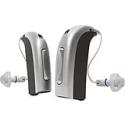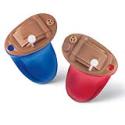Behind the Ear (BTE)

BTE hearing aids accommodate mild to profound hearing loss and can be worn by children and adults. The hearing device is housed in a small, hard case that is worn behind the ear. The case connects to an earmold that is worn inside the outer ear canal. Sound travels from the device outside of the ear into the customized earmold through connected tubing.
BTE configuration follows the contour behind the outer ear and can generally house more features, controls, and power than any other style of hearing aid. The custom-fit ear mold can be ordered in a variety of colors and styles. The tubing that connects the ear mold, as well as the ear mold itself, can be cleaned and replaced over time. The BTE with ear mold style is commonly used for children because the BTE can be reprogrammed as needed and the ear mold can be replaced as the child grows.
BTE hearing aids are also available as open fit aids, which transmit sound to the ear through a narrow tube that is inserted into the canal with an open dome. An open ear dome has small openings which allow for more natural sound perception and extra airflow due to the apertures in the ear dome. This style is so popular that more occluding ear tips have become available in order to accommodate greater degrees of hearing loss. This style is also beneficial for people who experience excessive ear wax buildup.
In the Ear (ITE)

ITE hearing aids are small devices that fit inside the outer part of the ear. This hearing aid style is barely visible and is used for mild to severe hearing loss. The hearing device is housed entirely within the aid. ITE aids may contain a telecoil, which is a device that allows the wearer to hear sound better when talking on the telephone. ITE aids are not recommended for children because the casings would need to be replaced in conjunction with ear growth
Canal

In-the-canal (ITC) and completely-in-canal (CIC) hearing aids are currently the smallest aids available and are used for mild to moderately-severe hearing loss. Canal aids are customized to the size and shape of a person’s ear canal. Customization allows wearers to hide the hearing aid partially or completely into the ear canal. These hearing aid styles may be difficult to manipulate and are not recommended for children. The small size of the canal aids limits the power and volume ability of the aid and are not recommended for severe or profound hearing loss.


